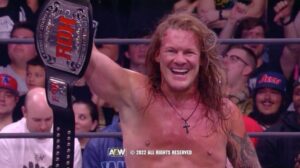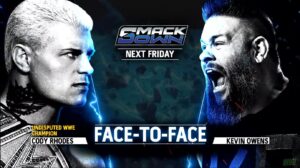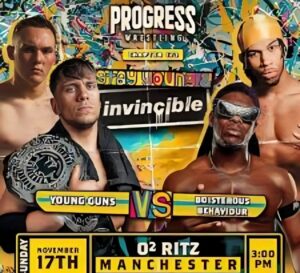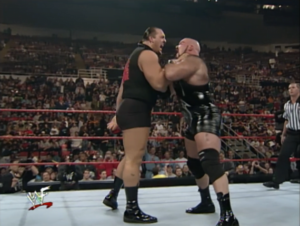Last week’s installment of this five-part series covered the early career of The Undertaker. The lesser known 1980s portion of his career was explored; assessing the debut of one of the most significant professional wrestlers of all time. Mark Calaway’s nearly-basketball career was covered, too. This part of the series will be covering Undertaker’s most active decade: the 1990s. Additionally, today happens to be The Undertaker’s birthday. Happy Birthday, Deadman!
The Career of The Undertaker: Recap
Part 1 left off with The Undertaker’s exit from World Championship Wrestling (WCW). Undertaker, who had been working in WCW for a year, was under-appreciated. He was told in no uncertain terms by head-booker, Ole Anderson, that “no one would ever pay to see you”. Paul Heyman, who was Taker’s (then Mean Mark Callous) manager at the time, then offered Taker’s services to the WWF. During the early part of 1990, Undertaker would meet with the man who would be his boss for the next thirty years: Vince McMahon.

During The Undertaker’s first meeting with Vince, The Undertaker made a fatal error. During the informal interview, Vince asked Taker “do you have any hidden talents?” Taker – wanting to make light of the situation – jokingly replied “well, you know, I sing in the shower pretty good.” Undertaker recently spoke of the incident on Steve Austin‘s Broken Skull Sessions WWE Network Show.
‘As soon as I said it i’m thinking “crap, i shouldn’t have said that”. at the time they’ve got some pretty outlandish gimmicks… on the inside i’m thinking “you screwed up, man. you’re going to be shower boy or something.”‘
McMahon must not have viewed the 6″9 Calaway as a reasonable casting choice for Shower Boy. Calaway was told that there was no spot for him. This caused the future Deadman to struggle for a while, as he had already handed in his notice and left WCW. A few months later, he would get the lucky phone call from Vince which would change both Mark Calaway’s life and the future of professional wrestling forever. “Undertaker, can you come down here tomorrow?” Of course, Taker went and so began a legendary WWE career.

The Early Days of Kane The Undertaker
Kane The Undertaker debuted on an episode of WWF Superstars on November 19th, 1990. It is interesting that the first name of The Undertaker is “Kane”. It is usually accepted within WWE lore that the Deadman character adopted it from his assumed dead brother, Kane. This early version of The Undertaker was unable to feel pain. A large part of the gimmick at the time was no-selling his opponent’s moves. In the past, Undertaker has compared the character to Jason Voorhees (Friday the 13th) and Michael Myers (Halloween). Two large, un-dead horror movies characters who moved slowly and could not feel pain. Though this was Taker’s official debut, the honor is usually given to Survivor Series 1990, which took place three days later. He debuted as a heel (with then-manager, Brother Love), assisting Ted DiBiase‘s team in their victory.
After a successful debut, The Undertaker would most feature in squash matches. Every week, The Undertaker – now managed by Paul Bearer – would defeat his opponent before taking them to the back in a body bag. This would become a staple of Undertaker’s character. Though Undertaker would be eliminated from the 1991 Royal Rumble, won by Hulk Hogan, he would put together an impressive undefeated streak. WrestleMania VII would be The Undertaker’s first big victory, where he would pin Jimmy “Superfly” Snuka in dominant fashion. This would begin an undefeated streak at WrestleMania lasting twenty-one years – a feat unmatched in pro-wrestling. Undertaker would then have feuds with The Ultimate Warrior and Sid Vicious before coming face-to-face with Hulk Hogan once more.
First World Championship (1991)
For as legendary as The Undertaker is, he is not so famous for holding world championships. Taker has only held the WWE Championship (in multiple forms) four-times. He has held the World Heavyweight Championship (Big Gold) three-times. Undertaker being a seven-time world champion in a career spanning thirty years is, therefore, quite surprising. However, the argument that Taker’s character does not need a belt is one which should be remembered. Like Bray Wyatt‘s “The Fiend” character, there is little sense to be made of an un-dead character of supernatural origin lusting over a world championship.
https://youtu.be/c0pqirT17zE
The Undertaker defeated Hulk Hogan – with the help of Ric Flair – for the then WWF Championship at Survivor Series 1991. The victory was exactly a year after his unofficial debut and at 26 years of age, made The Undertaker the youngest WWF Champion in history. The record would, however, be broken by Yokozuna two years later. Then on-screen president, Jack Tunney, ordered that Hogan be awarded a rematch, due to the questionable circumstances with which he lost the title. Just six days later, at This Tuesday in Texas, Hulk Hogan would win the championship back from The Undertaker. The title would then become vacated and be made the prize for the winner of the Royal Rumble match at the 1992 Royal Rumble, which would be won by Ric Flair.
The Undertaker Becomes a Fan Favorite (1992)
In February 1992, Jake “The Snake” Roberts tried to attack Miss Elizabeth with a chair but The Undertaker stopped him. For the first time, The Deadman was about to become a babyface. It is not easy to turn a gigantic, un-dead monster into a beloved babyface but Calaway has made a career out of it. If you were to look back through Taker’s career, he has been a babyface for most of it – especially over the last three decades (00s, 10s and 20s). Therefore, it is fitting that Taker’s second Mania win (at WrestleMania VIII) was as a babyface against one of all the time great heels in Jake Roberts.

After the victory over Roberts, The Undertaker – still a babyface – entered a feud with Harvey Wippleman. As a heel manager, Wippleman wanted to see Undertaker crushed by another monster. Kamala and Giant Gonzalez both tried their hand, with the latter becoming Undertaker’s third straight win at WrestleMania IX. The Undertaker also headlined the first Monday Night RAW during this period, pinning Damien Demento.
Redevelopment of The Deadman
The Undertaker would then feud with one more monster in the form of Yokozuna – the man who broke Undertaker’s record for youngest WWF Champion. At the 1994 Royal Rumble, Undertaker would lose a casket match against Yokozuna. This defeat would write The Undertaker off TV for seven months – causing him to miss WrestleMania X. This would be Undertaker’s first break from the WWF allowing him to focus on recovery from a grueling four years. It would also allow Calaway time to redevelop the character for the second half of the decade.

The Undertaker would return to the ring at SummerSlam 1994. Ted DiBiase, up until this point, had been managing a “new” Undertaker – affectionately dubbed “The Underfaker“. Therefore, it was only fitting that Taker would defeat the impostor – played by real-life cousin, Brian Lee – at SummerSlam. Undertaker debuted a new look, incorporating the color purple into his attire. This would be the first of many times Undertaker would dramatically change appearance. Just a few months later at Survivor Series 1994, The Undertaker would avenge his defeat to Yokozuna at the beginning of the year – locking the Samoan in a casket.
https://youtu.be/OTdYdIisXZw
The Undertaker would then spend much of 1995 feuding with various members of old foe Ted DiBiase’s Million Dollar Coporation faction. He would also extend his undefeated WrestleMania record to 4-0, after a victory over King Kong Bundy at WrestleMania XI. Going into 1996, Undertaker would feud with Kevin Nash – going by the name of Diesel. At WrestleMania XII, after a feud spanning months – which began when Diesel cost Taker a chance of reclaiming his WWF Championship against Bret “The Hitman” Hart, The Undertaker would make it 5-0 after a pinfall victory over Diesel. This would be The Undertaker’s first match at WrestleMania to go past the ten minute mark (16:46). The next part of 1996 would see The Undertaker enter into one of his most memorable feuds.
Sick & Twisted: The Undertaker and Mankind
1996 witnessed the birth of one of WWE’s all-time great characters: Mankind. Portrayed by WWE Hall of Famer, Mick Foley, Mankind was a psychotic, deranged boiler-room dwelling maniac who enjoyed inflicting pain on others. Additionally, he, too, thrived off pain. Only one night removed from his WrestleMania victory over Diesel, Mankind would debut to defeat Bob Holly – and then later inflict pain upon The Deadman. Mankind would haunt The Undertaker, costing him various matches over the course of the next few months. Most notably, he would cost The Undertaker a chance at winning the Intercontinental Champion from Goldust at In Your House 8: Beware of Dog. This would lead to the WWE’s first ever Boiler Room Brawl match, which would be won by Mankind after Paul Bearer’s betrayal.
In Your House 8: Beware the Dog took place in May of 1996. By the time of In Your House 11: Buried Alive in October of 1996, Mankind and Undertaker were still feuding. The feud didn’t grow cold, either; it maintained a sense of sustained brutality previously unseen within the WWE. It played a large part in the beginning of the Attitude Era and it is no surprise that both men would become figureheads of the Attitude Era’s roster heading into the Monday Night Wars.

The Undertaker: Back in Black
Though Undertaker would defeat Mankind at In Your House 11: Buried Alive, it would be Undertaker who would be buried alive. After interference from a number of superstars at the culmination of the match-up, the Deadman was buried alive. Just a few weeks later at Survivor Series 1996, Undertaker would take on Mankind again, with the stipulation that should he win, he gets his hands on Paul Bearer.
This match would also see The Undertaker debut a new look. Gone was the purple. In its place was a more gothic, darker looking Undertaker more in-line with the gritty brashness of the Attitude Era. Taker would indeed win the match, but Bearer would be saved by The Executioner. Taker would defeat The Executioner at In Your House 12: It’s Time, putting an end to the feud. Paul Bearer would then align himself with a recently debuted Vader, who would defeat The Undertaker at the 1997 Royal Rumble. The feud with Vader would continue for a short while, before The Undertaker would capture the WWF Championship at WrestleMania XIII. This would be his first time with the championship since losing it to Hulk Hogan six years earlier. Undertaker’s next two feuds would not only define a large part of the Attitude Era, but his entire career.
The Undertaker’s Brother Debuts
Immediately following Undertaker’s big victory at WrestleMania XIII, Paul Bearer would re-enter Undertaker’s life. He would announce that unless The Deadman take him back as his manager, he would reveal Undertaker’s “deepest, darkest secret”. For months, Bearer would reveal more and more backstory to the Undertaker character’s life. He had a brother, Kane, who would later turn out to be his half-brother – the result of an affair between Bearer and Taker’s mother. It was revealed that Undertaker burned down the family home. Then it was revealed that Kane, a pyromaniac, had in fact burned down the family home. It was one big family feud that would not have been out of place on Jerry Springer.

During this feud, Undertaker would lose his WWF Championship to Bret Hart at SummerSlam 1997, after Shawn Michaels mistakenly cost Undertaker the match. Undertaker would then face HBK at Badd Blood: In Your House. This would be the first-ever Hell in a Cell match. Additionally, it would also witness the debut of the Kane character.
In a now-iconic moment, Kane debuts; ripping the cell door off its hinges and costing The Undertaker the match. There is a reason why Kane’s debut is now seen as arguably the greatest of all-time. The build-up was prolonged, the execution was excellent. After the culmination to the initial feud at WrestleMania XIV (making it 7-0) and Unforgiven: In Your House‘s first Inferno Match, Kane – portrayed by Glen Jacobs – would go onto have a legendary career of his own. There will be more on Undertaker versus Kane in the next installment, covering the 2000s.
Legendary Match With Mankind
When discussing Undertaker’s career in the 1990s, it is impossible to do so without mentioning his King of the Ring 1998 match with Mankind. This was the match where Mankind was thrown off the cell. This is the same match where Mankind would later be thrown through the cell. Today, when similar spots occur during Hell in a Cell matches, there is always protection for the workers taking the bumps. At the time, Foley had no such protection. Undertaker summed it up in an interview with “you never know what that crazy sumb***h is going to do next”. The match, at the time, was pure insanity. Even by the standards of the current day, where big spots are more frequent, the bumps Foley took were blood-curdling.
This match, though disgustingly brutal, was a fitting end to the excellent feud between Mankind and Undertaker. Two real-life horror movie characters having an absolute nightmarish slug-fest was the only way this feud could end. It is also deserving of its place as one of the most recognizable matches in pro-wrestling history. The match would certainly take ten years off of Foley’s in-ring career, but it rightly cemented his place as a WWE Hall of Famer.
An End to the 1990s
The Undertaker would then spend much of the rest of the 1990s feuding with The Rock, Steve Austin (who he would win tag team gold with), Vince McMahon, DX, The Corporation, and others. He would have one more run with the WWF Championship, capturing it from Austin at Over the Edge 1999, though the victory was overshadowed by the tragic death of Owen Hart. His last WrestleMania victory of the 1990s was against Big Boss Man at WrestleMania XV. He would come close to signing with WCW – though he would remember Ole Anderson’s comments and Vince McMahon’s loyalty. Then, perhaps most importantly, he would begin transitioning away from the Deadman gimmick. He would begin riding motorcycles to the ring; he would begin talking trash on the microphone. That, however, is a story for Undertaker: Five Decades of The Deadman (Part 3), which will focus on Undertaker’s career throughout the 200s.
Stay tuned to the Last Word on Pro Wrestling for more on this and other stories from around the world of wrestling, as they develop. You can always count on LWOPW to be on top of the major news in the wrestling world, as well as to provide you with analysis, previews, videos, interviews, and editorials on the wrestling world. WWE and Undertaker fan? You can check out The Undertaker’s recent sit-down podcast with “Stone Cold” Steve Austin, as well as all of your favorite matches on the WWE Network.






